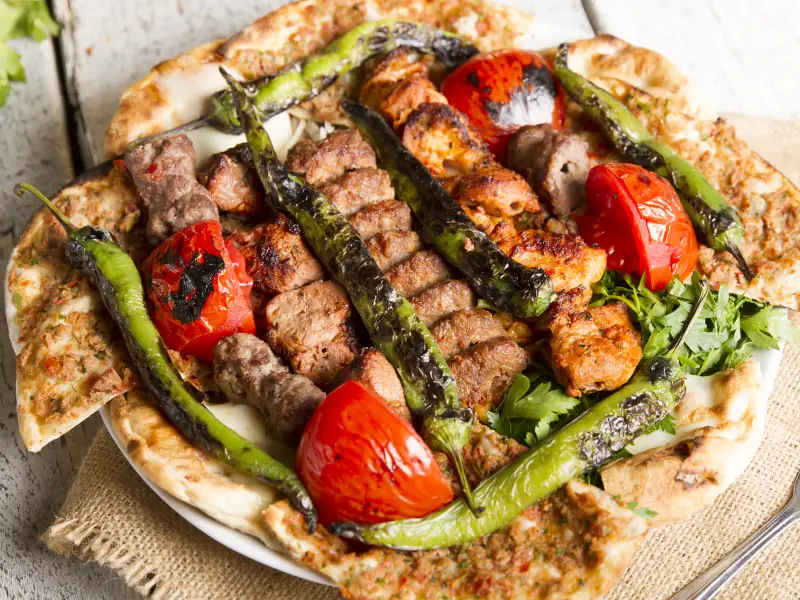The long history and the vast area of Iran have led to amazingly variant climatic conditions, cultural attractions, and natural landscapes. That is why Iran is famous as a destination for all four seasons, a land that offers loads of opportunities for all nature and adventure lovers who dream of various thrilling experiences such as climbing, canyoning, skiing, marine activities, and safari.
What is famous in Iran? Well, the best of Iran includes 24 UNESCO Cultural Heritage Sites and two UNESCO Natural Site as well as 13 Intangible Cultural Heritage registered on UNESCO and many more registered on Iran National Heritage List, that has made this country resemble like a live museum for all avid culture lovers, too. And surprisingly there are still more places you can visit!
Iran’s top attractions appeal to many international tourists from all around the world. Most itineraries offer 7 days to a 14-day tour to Iran, and yet they miss many tourist attractions in Iran! As long as you stay here, there is no shortage of Iran tourist attractions and there are places worth visiting.
If you have decided to visit historical places in Iran or Iran’s fascinating sceneries you can trust Iran Doostan Tours Co. We have a good three decades of experience in operating incoming tours to Iran and our professional experts would offer you the best Iran tourist map with reliable itineraries and high-quality services. Regarding a great deal of Iran attractions, we offer a diversity of package tours to Iran ranging from exciting adventure tours such as climbing and bird watching to awesome cultural tours to world heritage sites. MICE tours, safari tours, religious tours, and medical tours to Iran is also among the variety of services we offer.
All you have to do is to get in touch with us through info@idt.ir.
Posts
Top 6 Iranian food: So Tasty But Not Too Spicy
Iran, as a large country embracing different ethnicity with different cultures, is so diverse in culinary that every city enjoys a large variety of delicious foods unique to that area. Iranians love spices and use various seasonings for their food. Such as turmeric, saffron, black pepper, dried lemon, cumin, and so forth give a savory smell to the foods and make them delicious. Iranians use a lot of spice, but Persian food is usually tasty, not necessarily spicy. Iranian foods are a mixture of the most nutritious ingredients, including meat, rice, vegetables, beans, and spices. Iranians mix all those ingredients in such a balance that they turn into a delicious and nutritious meal. Kebabs, stews, and different kinds of rice (Chelow and Polo) are well-known Persian dishes.
Is Iranian Food Spicy?
Indeed, you can’t deny Iranians’ love for spices. They love using various kinds of seasonings to give their meal a mouthwatering smell and taste. In most Persian foods, Iranians use Saffron either as a garnish or for a better taste and aroma. Different spices are used in various dishes based on personal preferences, so Iranian food cannot be definitively defined as spicy. If you travel to Iran, you have the chance to experience making great Persian foods in major cities of Iran or the heart of nature. You can learn more about Iranian cuisine by reading our guest blog, which includes a foodie’s take on Persian cuisine in Iran. And finally, here are some of the most delicious and best Iranian foods introduced as follows:
Kebabs
Iranians love kebabs and enjoy the tasty flavor and smell of various kinds of kebabs, such as Joojeh Kebab and Kebab Koobideh. Joojeh Kebab (Chicken kebab), the Iranian favorite picnic food, is a very delicious meal, especially when made with fresh chicken marinated in yogurt, saffron, and lemon juice. Iranians are an expert at making Joojeh Kebab with boneless chicken breast cut into small pieces. Iranians usually grill Joojeh Kebab over hot coals when they go on a picnic and serve it with grilled tomatoes, onions, peppers, or rice.
Kebab Koobideh is also the most famous of all kebabs in Iran. Grilling Kebab Koobideh gives off an outstandingly delicious smell. Usually made from ground lamb or beef with chopped onion, Kebab Koobideh is a tasty dish that Iranians serve at formal ceremonies and during friendly picnics.
Gheymeh Nesar
Gheymeh Nesar of Qazvin is an incredibly delicious Persian jeweled rice with succulent pieces of lamb. The taste of rice, mixed with Persian barberries, pistachio, cinnamon, turmeric, rose water, and saffron, and garnished with orange pill slices and almond silvers, is heavenly tasty. Eating Gheymeh Nesar after visiting the historical attractions of Qazvin would be one of the most pleasant moments of your travel to Iran. There is no better place to taste this traditional Persian food than the friendly local houses of Qazvin in north-central Iran.
Ghormeh Sabzi
This is something special! You may have already heard about this famous Iranian food. Ghormeh Sabzi (Persian herb stew) is one of the most beloved stews among Iranians. You would rarely find someone who does not love Ghormeh Sabzi. A combination of different aromatic herbs, cooked lamb cubes, beans, and dried lemons make it very delicious. Iranians serve Ghormeh Sabzi alongside cooked rice (Chelo). Traditionally, Persian families serve Ghormeh Sabzi as the main dish in every household gathering. It somehow represents the love of the host towards its guests. If you were invited into a Persian household and they served you Ghormeh Sabzi, then you know! Make sure you don’t miss it on your trip to Iran.
The Northern cities of Iran have a variety of very delicious foods. Rasht and Deylaman are two of the northern cities of Iran offering various delicious foods such as Fesenjan, Mirza Ghasemi, and Baghali Ghatogh to tourists and travelers. Once traveling to the North of Iran, you will have the opportunity to enjoy making and eating such scrumptious meals.
Fesenjan
Fesenjan (Persian pomegranate and walnut stew) is a tasty stew integrated with Iranian culture. The ingredients are well-ground walnut, pomegranate sauce, and slow-cooked chicken or duck pieces. Iranians cook Fesenjan at a low temperature to let the tastes blend and release walnut oil on the stew. The well-mixed ingredients make a sweet and sour taste that is appetizing. Similarly to many other Persian stews, Iranians also serve Fesenjan with rice (Polo or Chelow). Fesenjan, as an Iranian cuisine, is considered a luxury dish often served during Persian wedding ceremonies. If you ever get an invitation to an Iranian wedding party, you can taste this luscious fare.
Mirza Ghasemi
In order to make this delicious dish, Iranians grill the eggplants until the skin is charred and peeled off. Then, they add a lot of garlic, tomatoes, salt, and pepper to the grilled eggplants. For the final step, eggs are mixed with the ingredients to give the dish an excellent taste. Locals of the northern part of Iran serve Mirza Ghasermi as an appetizer, side dish, or the main dish, with Persian bread or rice. Since it is a simple meal by only grilling the eggplants on fire, you can easily make such a delicious meal once you enjoy being in the forests of Gilan.
Baghali Ghatogh
Baghali Ghatogh is an easy, healthy, and tasty Persian dish, one of the most popular northern Iranian dishes. It is one of the quickest dishes getting ready in less than an hour. Baghali Ghatogh is also a vegetarian dish, including aromatic dills, garlic, fresh beans, eggs, salt, and pepper. Iranians serve Baghali Ghatogh with bread or rice. If you ever take a trip to the northern region of Iran, make sure to taste this delicious traditional Persian food.
Are you planning to travel to Iran? Check out our Iran food tour.
Iranian festivals and ceremonies as tourist attractions
Festivals, rituals, events, and traditions are among the variety of interesting factors that make a distinction. The distinction is a critical factor motivating tourists to travel around the globe. In addition to its historical importance, Iran has a variety of ancient traditions still practiced by its people. Here are some of the most famous Iranian festivals and ceremonies explained in detail to help you get familiar with Iranian culture. If you are planning to visit Iran, here is the link to Iran online visa form.
Chaharshanbeh Suri
Chaharshanbe Suri, known as the Festival of Fire, is one of the Iranian festivals celebrated on the eve of the last Wednesday before Nowruz. The origin of the festival dates back to the early Zoroastrian era. This festival is celebrated with fireworks displays and jumping over fires. People gather by the fire, jump over it, and they say to the fire, “Give me your beautiful red color and take my sickly pallor!”
People believe that the red color of fire symbolizes health. Iranians perform a variety of traditions on this night. Nearly every city in Iran has a custom of jumping over a fire and buying sweet and sour nuts. It is believed that eating nuts will make your wishes come true at the Chaharshanbe Suri Festival. Ash Reshteh, a Persian stew, is a tradition that makes this festival astonishing.
Nowruz
As the start of the New Year, Nowruz is one of the most celebrated Iranian festivals worldwide among Iranians and other ethnolinguistic groups. Persian New Year begins at the end of the freezing days of winter when the fresh mild days of spring are celebrated for 13 days, starting on March 21, the first day of spring in Iranian calendars.
Since Nowruz begins at the exact moment of the vernal equinox, the moment of celebrating the New Year differs each year. In order to determine Nowruz’s actual time, a Jalali calendar is used.
UNESCO included the Nowruz of Intangible Cultural Heritage of Humanity in 2010. Consequently, the UN General Assembly recognized March 21 as the International Day of Nowruz. Setting ‘Haft Seen’ is a meaningful custom of Nowruz.
Sofreh or tablecloth includes Seven (Haft) symbolic edible herbs and fruits, each starting with the letter ‘Seen’ in the Persian Alphabet (pronounced as the S letter in English). During the 13 days of Nowruz, relatives and friends visit each other and say “Happy New Year” to one another, eat delicious sweets, and wish each other a Happy New Year.

Setting “Sofreh Haft Seen” or Haft seen tabletop is an interesting custom of Nowruz.
Mehregan
Autumn starts with the month of Mehr (the seventh month of the year) in Iran, and its 16th day is called Mehregan, which is the celebration of light, friendship, kindness, and love in the Avestan calendar. Mehr means sun in Persian culture, which is said to be the eye of Mitra, the goddess of light. It is also Thanksgiving Day for Iranian farmers.
In ancient times, Mehregan was harvest day, and some crops were gifted to the king. People spend this day visiting their loved ones, especially the ones that have been missed for a long time to enjoy the beauty of this vibrant-colored season together, and this celebration used to be among the most prominent Iranian festivals.
One lovely tradition is throwing a handful of noghl (sugar plum) over one another’s heads before exchanging hugs and kisses. Mehregan festival is full of love, light, friendship, and kindness.

A painting on the celebration of Mehregan, a Thanksgiving Day for the Iranian farmers.
Shab-e-Yalda (Yalda Night)
Shab-e-Yalda (Yalda Night), also known as Shab-e Chelleh, is one of the most ancient Iranian festivals annually celebrated on December 21 by Iranians worldwide. It is the last night of autumn and the longest night of the year. Yalda means birth, referring to the birth of Mitra, the mythological goddess of light. Since days get longer and nights shorter in winter, Iranians celebrate the last night of autumn as the renewal of the sun and the victory of light over darkness.
On Yalda night in Iran, people gather in groups of friends or relatives and usually at the home of grandparents or the elderly to pass the longest night of the year happily by eating nuts and fruits, reading Hafiz poems, making good wishes, and talking and laughing all together.
The Iranians celebrate this special night by eating nuts, watermelons, and pomegranates. Some believe that Pomegranate is a symbol of birth and its bright red seeds symbolize the glow of life. Reading poems from Divan-e-Hafiz is another fascinating tradition of Yalda Night. Every member of the family or a group of friends makes a wish and randomly opens the book. Then the eldest member of the family or friends reads the randomly selected poem loudly.
Since the poem is believed to be the interpretation of the wish and the way it would come true, it is fun to interpret the poem and guess the wishes others make. So, autumn’s last and longest night passes happily, and winter’s first great day begins.

Yalda Night, one of the most ancient Iranian festivals annually celebrated on December 21.
Tasua and Ashura
The days of Tasua and Ashura are the 9th and 10th of Muharram (the first month of the Islamic calendar). Shia Muslims commemorate the battle of Karbala that occurred in 680 AD. The Muslim’ Prophet’s grandson” Hossein” and his 72 relatives and supporters died in this battle. Muharram rituals are an example of cultural-religious ceremonies among Shia Muslims.
They are held annually in the form of a mass movement in Iran. People usually dress in black and rally in the street during Muharram in Iran. Some carry huge metal pieces decorated with flags and lead the crowd. Some beat their drums, some hit their backs with chains, and others accompany the mourning ones.
Many families cook Iranian food that is called Nazri. Then, they distribute Nazri food or drinks among all the people. Tourists can also participate in making food or distributing it.

The Nakhl (palm tree) is a huge structure in the shape of a large leaf or the cypress tree which symbolizes the coffin of Imam Hossein and his martyr companions.
Conclusion
Iranian festivals and ceremonies are a vibrant representation of the nation’s rich cultural and historical heritage. These events, ranging from the ancient Nowruz to the solemn Ashura, offer profound insights into the values, traditions, and communal spirit of the Iranian people. They serve not only as a means of preserving and celebrating Iran’s diverse cultural identity but also as opportunities for social cohesion and reflection. Ultimately, these festivals and ceremonies highlight the enduring importance of cultural rituals in fostering a sense of unity and continuity within Iranian society.
If you have decided to travel to Iran, get more information on Iran visa.















